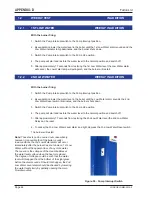
JGASUK-IOMM-2015-2
Fulton Ltd
Page 63
APPENDIX - E
APPENDIX E - AUTOMATIC
TDS BLOWDOWN SYSTEM
1.1
GENERAL
The purpose of an Automatic, Total Dissolved Solids (TDS) Control Blowdown System, is to
control the TDS level within the boiler around a set point. It is not a substitute for the main boiler
blowdown, which must be used to control suspended solids, and prevent the build-up of sludge in
the bottom of the boiler. The daily testing of boiler water level controls is a mandatory requirement
as defined in the Health & Safety Executive Guidance Note BG01, Arrangement 3.
The method of operation is to take a sample of the boiler water at pre-set timed intervals, pass
the sample over an electrode which measures water conductivity (which is proportional to TDS
for a given water chemistry), and then compares the result with the control value (normally 2000
ppm), which is set when the unit is commissioned.
If the sample value is higher than the control value, the blowdown solenoid valve opens in a
series of pulses until the measured value corresponds to, or is lower than, the set value. When
this is achieved, blowdown finishes until the next timed sample is taken when the process is
repeated. Should the sample value be lower than the set value, blowdown is deferred until the
next timed sample.
For the system to function reliably, the control must be calibrated to a typical water sample that is
representative of the water conditions that are likely to prevail during normal running of the boiler
and system. Conductivity and as a consequence TDS, can vary significantly with water chemistry.
Changes in condensate return rates, alkalinity, chemical dosage, and suspended solids can all
affect the performance of an Automatic TDS Blowdown System.
Condensate return rates that vary greatly on a day to day basis can severely disrupt the reliability
of the conductivity measurement.
e.g. A boiler with a 50% condensate return and a raw water
TDS of 400 will have a boiler feed water TDS of 200 ppm.
Figure. 39 - TDS Graph 1
Summary of Contents for J Series
Page 2: ...JGASUK IOMM 2015 2 Fulton Ltd Page II ...
Page 54: ...JGASUK IOMM 2015 2 Fulton Ltd Page 48 APPENDIX A ...
Page 58: ...JGASUK IOMM 2015 2 Fulton Ltd Page 52 APPENDIX A ...
Page 60: ...JGASUK IOMM 2015 2 Fulton Ltd Page 54 ...
Page 62: ...JGASUK IOMM 2015 2 Fulton Ltd Page 56 ...


















